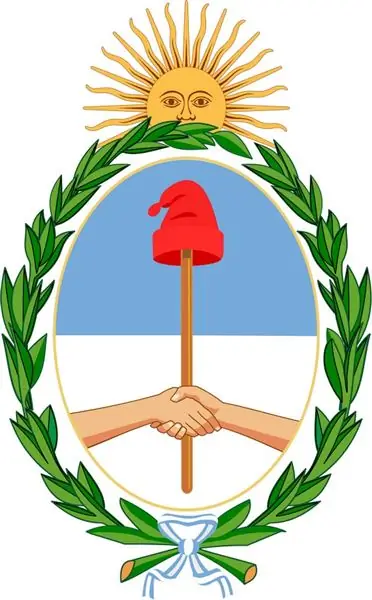
The states of Latin and South America have recently embarked on an independent path of development. Therefore, many of these countries have very young state symbols. The same coat of arms of Argentina was officially approved as the main symbol of the country only in 1944. True, it is based on images of symbols, symbolic for the country, marked with the stamp of history.
Description of the coat of arms of the Argentine Republic
The central fabric of the coat of arms is presented in the form of an oval shield. Its field is divided by a horizontal line into two equal parts, painted in different colors: the upper part is azure (or more familiar, blue), the lower part is silver, most often transmitted using white.
Among the main symbols on this shield are a staff and a Phrygian cap wearing it. The colors are natural, natural, the staff is brown, the cap is bright red. In the foreground, on a silver background, the image of a handshake. Around the shield is a wreath of green branches of a laurel tree. From below, these branches are connected and tied with a ribbon; the same colors are used for its decoration as on the shield. The main background of the ribbon is silver, the border is azure. The sunrise is shown above the shield.
Each of these symbols, even if it seems to someone primitive, is filled with meaning and can tell a lot to a person who is keen on the history of Argentina.
Symbols of the revolution
The cap depicted on the state emblem of this country is called Phrygian or Thracian, in honor of the region of Phrygia. Once it was in Asia Minor, for many it has become a kind of symbol of freedom or revolution.
In fact, representatives of the tribes inhabiting Dacia, Thrace and Dalmatia wore such a felt or woolen hat. The right to wear it in Ancient Rome or Greece was given to a slave who was set free. It is clear that the one who had such a cap on his head was a free person.
Since the color of the cap was very bright and saturated, when putting it on a staff, it could serve as a banner calling for rebellion, liberation. The Phrygian cap lost its original meaning as an ordinary headdress and acquired a symbolic one, moreover, in different countries and at different times.
For example, such a headdress is worn by Marianne, which is a symbol of freedom of France, the Statue of Liberty on some American coins. This symbol is most widespread in Latin and South America. His image is on many coats of arms, including the Argentine Republic.






